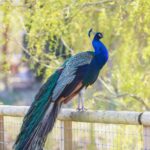Peacocks are highly revered in Buddhism. Peacock symbolism in Buddhism is one of purity, and the feathers of a peacock are used in purification ceremonies. Peacocks also signify acceptance, openness, and enlightenment.
Table of Contents
What Does a Peacock Symbolize in Buddhism?
I’ve done a lot of research into where peacocks are mentioned in Buddhism texts, how they’re seen in Buddhism, and the things that are said about peacocks.
There is always one consistent theme, peacocks symbolize purity to Buddhists.
The origin of this seems to tie back to the fact that peacocks were seen eating plants that were poisonous to humans without showing any ill effects.
To Buddhists, this symbolized peacocks in enduring suffering. This is interesting because one of the key things Buddhists believe is that human life is one of suffering.
Buddhists believe that through spiritualism, meditation, and some other practices they’re able to achieve enlightenment.
So, it’s easy to see how they would have seen peacocks as pure and spiritual as they were able to eat poisonous plant matter.
There are also a number of books looking at how peacocks are seen in Buddhism. One well-known book written by a Buddhist Monk is called Peacock in the Poison Grove: Two Buddhist Texts on Training the Mind.
In this book, a Tibetan Buddhist Monk looks at how the mind can be trained through yogic methods to dispel selfish delusions of the ego and to maintain one’s purity.
This gives some interesting insights into how Buddhists saw peacocks thousands of years ago and what they symbolized to the Monks back then as well as what we know today.
Related - What Does It Mean When a Peacock Crosses Your Path?
What Does a Peacock Symbolize in China?
The peacock is one of the Twelve Symbols of Sovereignty, which is a symbolic interpretation of the universe - so peacocks are prominent in Chinese culture and history.
Although often referred to as a peacock, the symbol is usually named a pheasant. But peacocks are part of the pheasant family and the image in the symbol looks like a peacock.
Peacocks were featured frequently during the Ming Dynasty, where they were used to display power, beauty, rank, and divinity.
On a broader perspective, peacocks are commonly used to represent beauty and power in China and Chinese people see them as bringing good luck and fortune.
They are often depicted with their tail feathers spread out and lots of the 'eyes' in their feathers being displayed.
What Does a Peacock Symbolize in Indian Culture?
Peacocks are even more revered in India and within Indian culture and history.
The Indian Blue Peafowl, the most iconic of the peafowl species, is native to India as the name suggests.
In fact, the Indian peafowl is the National Bird of India - what higher esteem can a bird have? They are protected in India where there are large Buddhist populations and a huge population of Hindus.
So, what do peacocks symbolize in India and to Hindus?
There isn't the same talk about purity as there is within Buddhist culture. Instead, peacocks are symbols of pride, beauty, and grace in India.
This is not uncommon around the world, as obviously peacocks are known for their stunning feather displays.
According to TimesOfIndia, the peacock was declared the National Bird of the country because of its rich history of being involved in religious and legendary Indian traditions.
Such stories being of a god called Kartikeya riding on the back of a peacock, and the ability for peafowl to charm snakes and addle their eggs.
What Is the Symbolic Meaning of Peacock?
Peacocks symbolize different things to different cultures around the world.
I've covered what they symbolize in Buddhism, and for the most part, they symbolize good luck and other positive things.
In some parts of the Western world, however, peacock's feathers are a symbol of bad luck.
This is almost exclusively down to the Mongols wearing peacock feathers in their hats when they went into battle.
A lot of countries that they conquered or terrorized still associate peacock feathers and peacocks in general as a sign of bad luck.
For the most part, the symbolic meaning of a peacock is that of beauty, pride, and confidence.
All the things peacocks themselves exhibit when they are fanning their tail feathers out tall and proud.
Their colors also represent truth and regrowth and to be your best self. If you see a peacock fanning its tail at you, it's said that you should take a look at how authentic and true to yourself you’re being.
Related - Peacock Feathers Meaning Bad Luck or Good Luck? (Both Sides Explored)
In Summary
The history and symbolism of peacock in Buddhism is interesting. As is the symbolism of this magnificent bird in various other cultures and countries.
Buddhists looked at peacocks as symbolizing purity and immortality due to their ability to eat plants that are toxic to us.
They were unique with this view compared to what peacocks symbolize to other cultures.
Whatever you believe in, your religion, or your culture, there is no denying the peacocks are magnificent and magical birds.
Resources
Image credits - Photo by Viktor Shimin on Unsplash




